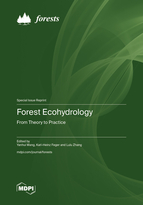Forest Ecohydrology: From Theory to Practice
A special issue of Forests (ISSN 1999-4907). This special issue belongs to the section "Forest Hydrology".
Deadline for manuscript submissions: closed (31 December 2022) | Viewed by 19782
Special Issue Editors
Interests: forest hydrology; forest ecology; forest soil; forest ecosystem service; multifunctional forestry and forest management
Special Issues, Collections and Topics in MDPI journals
Interests: environmental impact assessment; environmental analysis; water resources management; hydrological modeling; soil; water quality; climate change; rivers; plant ecology
Interests: environmental science; climate change; water balance; watershed hydrology; hydrological modeling; soil and water conservation; soil science; environmental impact assessment
Special Issue Information
Dear Colleagues,
The newly emerging field of forest ecohydrology aims to understand, quantify and utilize complex forest–water interactions. Forests’ impacts on water (quantity, quality, and timing) have been studied in traditional forest hydrology, firstly focused on the impacts of forest cover, but increasingly also with forest structure and spatiotemporal patterns. However, the dynamic responses of forest ecosystems to water availability and other factors are slow and often delayed, and therefore less studied. Moreover, scale-dependent and site-specific forest–water interactions must be interpreted by the combined ecological and hydrological process response to influencing factors and management schemes. This is vitally important for the development of forest ecohydrology. Against this background, this Special Issue welcomes studies presenting new knowledge, innovative methods/techniques and models of forest ecohydrology. This includes: 1) the responses of structural dynamics and the spatial patterns of forests to water-related and other factors; 2) the mechanism and scale effect of forest hydrological impacts; 3) the coupling of forest eco- and hydrological processes and modelling; 4) application cases of forest ecohydrology in forest management for desired ecosystem services. Original research and reviews targeted at the understanding, quantification and utilization of forest–water interactions at various scales are particularly encouraged.
Prof. Dr. Yanhui Wang
Prof. Dr. Karl-Heinz Feger
Dr. Lulu Zhang
Guest Editors
Manuscript Submission Information
Manuscripts should be submitted online at www.mdpi.com by registering and logging in to this website. Once you are registered, click here to go to the submission form. Manuscripts can be submitted until the deadline. All submissions that pass pre-check are peer-reviewed. Accepted papers will be published continuously in the journal (as soon as accepted) and will be listed together on the special issue website. Research articles, review articles as well as short communications are invited. For planned papers, a title and short abstract (about 100 words) can be sent to the Editorial Office for announcement on this website.
Submitted manuscripts should not have been published previously, nor be under consideration for publication elsewhere (except conference proceedings papers). All manuscripts are thoroughly refereed through a single-blind peer-review process. A guide for authors and other relevant information for submission of manuscripts is available on the Instructions for Authors page. Forests is an international peer-reviewed open access monthly journal published by MDPI.
Please visit the Instructions for Authors page before submitting a manuscript. The Article Processing Charge (APC) for publication in this open access journal is 2600 CHF (Swiss Francs). Submitted papers should be well formatted and use good English. Authors may use MDPI's English editing service prior to publication or during author revisions.
Keywords
- forest ecohydrology
- stand structure
- spatial distribution
- hydrological process
- ecological process
- scale effect and scaling
- ecohydrological models
- forest-water interaction
- integrated forest-water management
- forest ecosystem service








